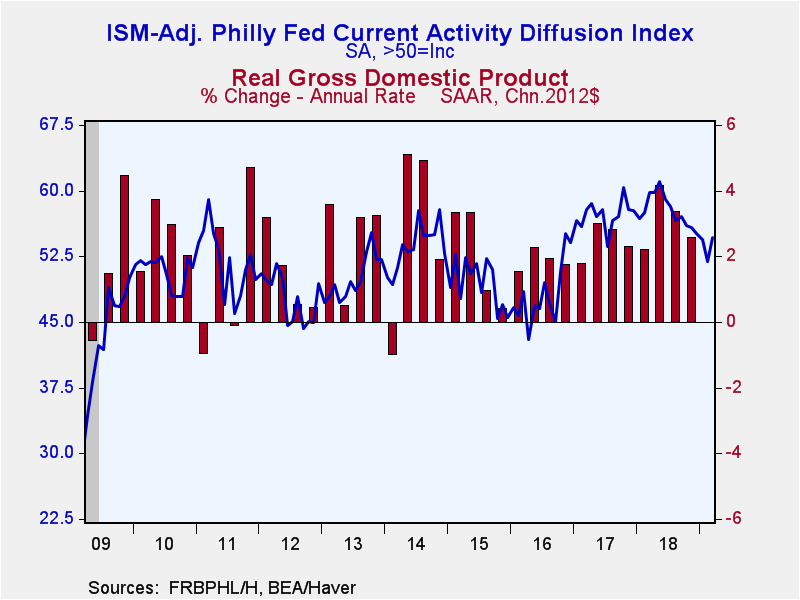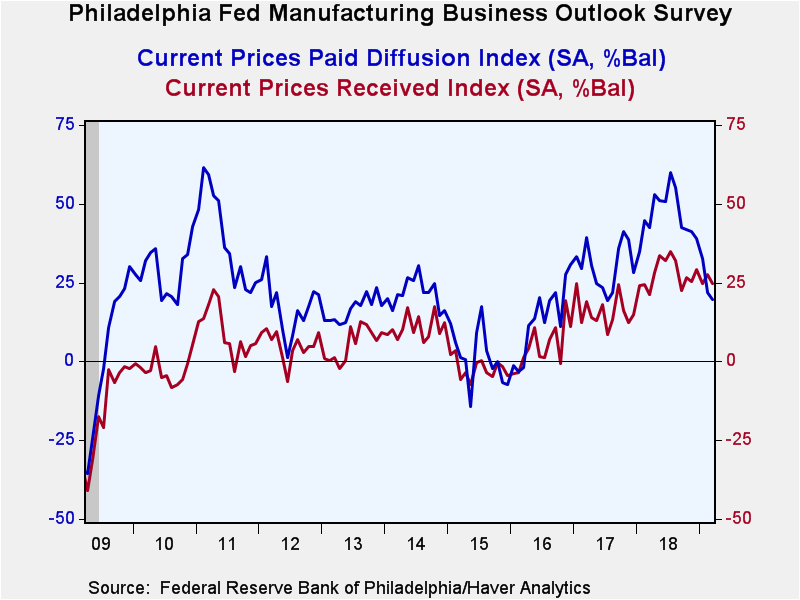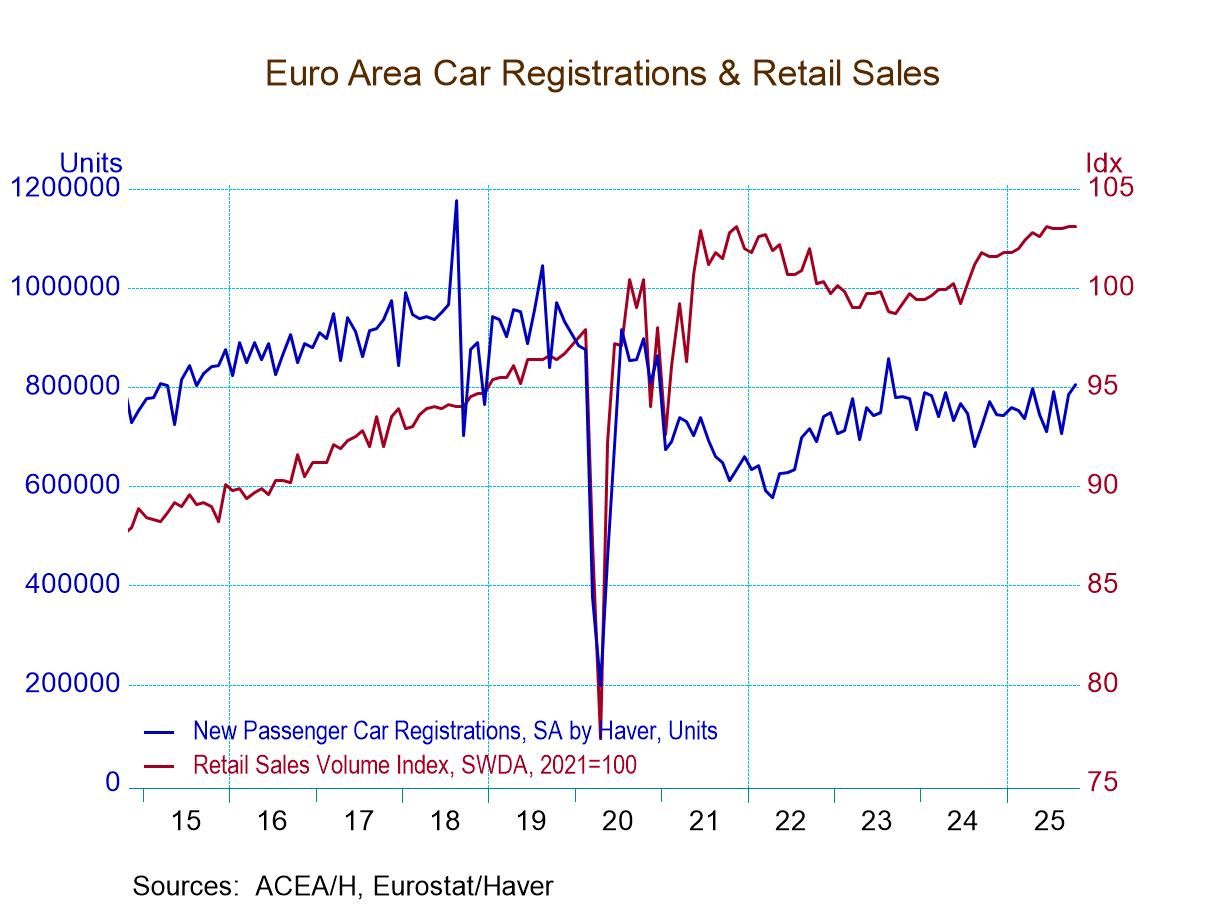 Global| Mar 21 2019
Global| Mar 21 2019Philadelphia Fed Manufacturing Index Rebounds But Prices Weaken
by:Tom Moeller
|in:Economy in Brief
Summary
The Federal Reserve Bank of Philadelphia reported in its Manufacturing Business Outlook Survey that the General Business Conditions Index rebounded this month to 13.7 after declining in February to -4.1. A lesser rise to 7.0 had been [...]
The Federal Reserve Bank of Philadelphia reported in its Manufacturing Business Outlook Survey that the General Business Conditions Index rebounded this month to 13.7 after declining in February to -4.1. A lesser rise to 7.0 had been expected in the Action Economics Forecast Survey. Despite the surprise, the gain failed to recover all of February's weakening and left the survey reading well below the peak in early-2017. As such, it indicates continuing softness in factory sector growth. Thirty percent of respondents reported an increase in activity and nineteen percent reported a decline.
Haver Analytics constructs an ISM-Adjusted General Business Conditions index based on these results. It rose to 54.7 and made up its February decline. The rise still left the index significantly below last May's peak level. During the last dozen years, there has been a 66% correlation between the index and quarterly growth in real GDP.
Performance amongst the components of the overall index was mixed this month. A recovery in the shipments index led the gain along with higher new orders and inventories readings. Continuing to weaken were the unfilled orders and delivery times indexes.
On the labor front, the employment series returned to the lowest level since September 2017. A significantly lessened twenty percent of respondents reported increased hiring while a steady ten percent reported a decline. During the last dozen years, there has been a 78% correlation between the jobs index and the m/m change in factory sector payrolls. The employee workweek figure increased moderately to the highest level since October.
Pricing power continued to weaken. The prices paid index declined to the lowest level since July 2017, and was one-third the level in July of last year. A significant lessened twenty-four percent of respondents reported higher prices while a lessened four percent paid less. The index of prices received eased m/m and has trended sideways for six months.
The expectations series declined to the lowest level since early-2016 due to broad-based component weakening. Expected orders and shipments declined notably. The employment reading remained significantly below the series' high.
The survey panel consists of 150 manufacturing companies in the third Federal Reserve District (which consists of southeastern PA, southern NJ and Delaware). The diffusion indexes represent the percentage of respondents indicating an increase minus the percentage indicating a decrease in activity. The ISM-adjusted figure, calculated by Haver Analytics, is the average of five diffusion indexes: new orders, shipments, employment, delivery times and inventories with equal weights (20% each). Each ISM-adjusted index is the sum of the percent responding "higher" and one-half of the percent responding "same."
The figures from the Philadelphia Federal Reserve dating back to 1968 can be found in Haver's SURVEYS database. The expectation from the Action Economics Forecast Survey is available in AS1REPNA database.
| Philadelphia Fed - Manufacturing Business Outlook Survey (%, SA) | Mar | Feb | Jan | Mar'18 | 2018 | 2017 | 2016 |
|---|---|---|---|---|---|---|---|
| General Factory Sector Business Conditions | 13.7 | -4.1 | 17.0 | 23.8 | 21.1 | 27.3 | 4.9 |
| ISM-Adjusted Business Conditions | 54.7 | 51.9 | 54.4 | 59.8 | 57.7 | 57.3 | 48.2 |
| New Orders | 1.9 | -2.4 | 21.3 | 27.4 | 21.0 | 25.3 | 5.0 |
| Shipments | 20.0 | -5.3 | 11.4 | 28.2 | 22.8 | 26.8 | 6.9 |
| Unfilled Orders | 3.1 | 6.9 | 5.4 | 17.3 | 7.1 | 11.9 | -5.6 |
| Delivery Time | 8.8 | 13.6 | 13.4 | 13.2 | 9.5 | 10.6 | -4.6 |
| Inventories | 17.2 | 3.3 | -7.6 | 13.6 | 7.4 | 2.9 | -9.6 |
| Number of Employees | 9.6 | 14.5 | 9.6 | 25.2 | 21.6 | 16.1 | -5.6 |
| Average Workweek | 10.6 | 4.7 | 6.0 | 12.7 | 15.9 | 14.9 | -5.4 |
| Prices Paid | 19.7 | 21.8 | 32.7 | 42.6 | 46.4 | 30.4 | 13.5 |
| Expectations - General Business Conditions; Six Months Ahead | 21.8 | 31.3 | 31.2 | 46.2 | 36.9 | 47.1 | 33.7 |
Tom Moeller
AuthorMore in Author Profile »Prior to joining Haver Analytics in 2000, Mr. Moeller worked as the Economist at Chancellor Capital Management from 1985 to 1999. There, he developed comprehensive economic forecasts and interpreted economic data for equity and fixed income portfolio managers. Also at Chancellor, Mr. Moeller worked as an equity analyst and was responsible for researching and rating companies in the economically sensitive automobile and housing industries for investment in Chancellor’s equity portfolio. Prior to joining Chancellor, Mr. Moeller was an Economist at Citibank from 1979 to 1984. He also analyzed pricing behavior in the metals industry for the Council on Wage and Price Stability in Washington, D.C. In 1999, Mr. Moeller received the award for most accurate forecast from the Forecasters' Club of New York. From 1990 to 1992 he was President of the New York Association for Business Economists. Mr. Moeller earned an M.B.A. in Finance from Fordham University, where he graduated in 1987. He holds a Bachelor of Arts in Economics from George Washington University.










